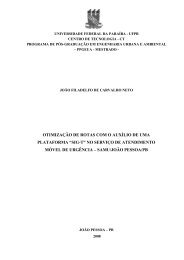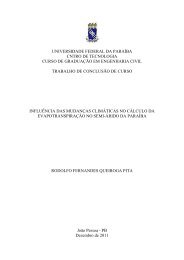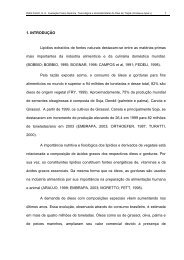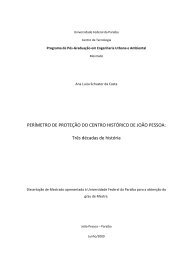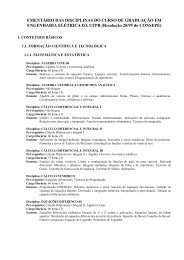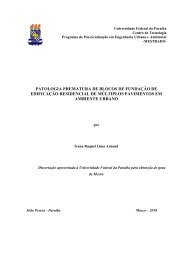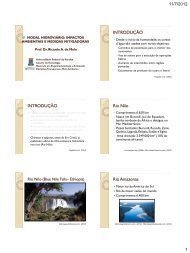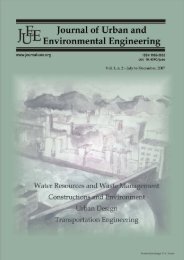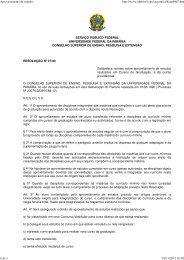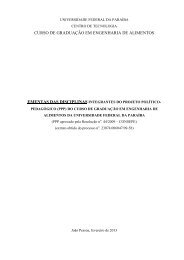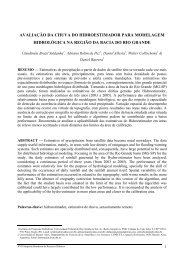editorial team
editorial team
editorial team
Create successful ePaper yourself
Turn your PDF publications into a flip-book with our unique Google optimized e-Paper software.
Bennajah, Maalmi, Darmane and Touhami<br />
43<br />
25<br />
Concentration of F-(mg/L)<br />
20<br />
15<br />
10<br />
exp Ci= 10 mg/l<br />
model Ci= 10 mg/l<br />
exp Ci= 15 mg/l<br />
model Ci= 15mg/l<br />
exp Ci= 17mg/l<br />
model Ci= 17mg/l<br />
exp Ci= 20 mg/l<br />
model Ci= 20 mg/l<br />
5<br />
0<br />
0 5 10 15 20 25 30<br />
Time (min)<br />
Fig 4 Influence of the initial concentration (pH i = 7.4, κ=6.1 mS cm -1 , j =17.1 mA cm - ²).<br />
The relative weak efficiency concerning 0.5 A is<br />
attributed to the weak charge loading produced in this<br />
case; 0.47 F m -3 . Thus, the quality of EC depends of the<br />
amount of coagulant produced in situ. More than<br />
0.47 F m -3 is needed to have a better efficiency; in this<br />
study it is shown that this amount is 0.9 F m -3 . A<br />
comparison with the data of Mollah et al. (2001)<br />
showed that 5–6 F m -3 is required to achieve 1.5 mg L -1<br />
with [F - ] 0 between 10–15 mg L -1 .<br />
We can see also from Fig. 4 that the model of VOK<br />
with Langmuir-Freundlich fits the experimental data<br />
very well. Thus, the expected values of q max are close to<br />
1 as found in the adsorption isotherms study (Table<br />
2).These values are used to fit experimental data. The<br />
coefficient n is greater than 1 indicating that positive<br />
cooperativity is assumed (Prauss et al., 2007). The<br />
adsorption on the floc takes place on the external<br />
surface and intercalation into the interlayer space at the<br />
same time.<br />
Effect of initial concentration<br />
The experiments were conducted in ALR by changing<br />
initial fluoride concentration from 10 to 20 mg L -1 ,<br />
keeping all other experimental conditions unchanged<br />
(j = 17.1 mA cm -2 , pH = 7.4, κ = 7.5 mS cm -1 ).<br />
Figure 4 demonstrates that the rate of defluoridation<br />
was significantly influenced by the initial concentration<br />
of fluoride. The retention time (t N ) required for an<br />
acceptable residual fluoride concentration decreases<br />
when the initial concentration increases. This figure<br />
presents also the results of simulation using the VOK<br />
model for various initial fluoride concentrations. The<br />
same tendency of the simulation result is obtained as for<br />
the case of the influence of current density (Fig. 4). The<br />
figure shows that the model represents very well the<br />
experimental data for all initial concentrations with<br />
identical parameters (n = 1.15, K = 1600, q max = 0.75).<br />
It should be noted that our results were modelled for<br />
a time ranging from 0 to 24 minutes, whereas for the<br />
simulation of Hu et al. (2008) and Hu et al. (2003) the<br />
operating time does not exceed 9 minutes. Moreover,<br />
our work, both in airlift and stirred reactor, the S/V ratio<br />
used is lower (0.875 m 2 m -3 ) than that used in<br />
conventional EC cells, in which the S/V ratio is high,<br />
between 10 and to 40 m 2 m -3 (Mameri et al., 2001). HU<br />
et al. (2003) and Hu et al. (2007) have demonstrated<br />
that in this case, electrode removal was primarily<br />
responsible for defluoridation efficiency, while other<br />
mechanisms gave only a secondary effect. In our case,<br />
the mechanisms involved are in the bulk, i.e.<br />
coprecipitation and adsorption.<br />
The mode of adsorption is so complicated to be<br />
represented by the Langmuir model because the<br />
quantity of adsorbent changes with time contrary to the<br />
conventional adsorption, and because adsorption takes<br />
place also in multi-layers.<br />
CONCLUSION<br />
A variable order kinetic (VOK) derived from the<br />
Langmuir-Freundlich equation was developed to<br />
simulate the kinetics of the defluoridation with EC using<br />
bipolar aluminium electrodes in the airlift reactor. The<br />
results showed good agreement between the predictive<br />
Journal of Urban and Environmental Engineering (JUEE), v.4, n.1, p.36-44, 2010



